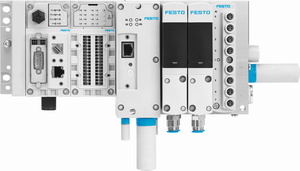

|
Edward Lowton
Editor |


|
| Home> | Plant, Process & Control | >Compressors and ancillary equipment | >Improving sustainability using controlled proportional pneumatics |
Improving sustainability using controlled proportional pneumatics
28 April 2023
Process gas price rises have strengthened the case for carefully re-evaluating the technology used to control flow and pressures, says Steve Sands

RISING ENERGY prices are pushing up the cost of process gases. This not only applies to compressed air, but also to inert gases, oxygen, and exotic gases. The price hikes have wide-ranging consequences because these gases are used for many everyday applications, from food packaging and tyre inflation to highly precise and technical applications in semiconductor production and scientific research.
Knock-on effects throughout the supply chain are inevitable because production of even the most basic foods, medicines and industrial components is dependent upon the cost of the gases they consume. To remain competitive, manufacturers need to use process gases more efficiently and sustainably. This involves a careful re-evaluation of the technology used to control flow and pressures.
Manual or electric?
Whether the application requires the flow or pressure to be controlled, the decision to use either manual or electric regulation is an important one. Manual pneumatic flow controls are simple, ‘fit and forget’, low-cost throttles. However, a poorly set air blast or cooling jet will often consume many times its initial cost in the air or gas that it wastes.
Manual pressure regulators are marginally more complicated, but again they require very little knowledge to set up and operate. Initial adjustment is often done by trial and error based on the setters’ experience; traditional gauging is often inadequate for precision setting. Once in operation, it is common for these devices to be adjusted in the field without considering the potential wastage or impact on output quality.
Electric regulating devices can be open or closed loop. In open-loop devices, the aim is to achieve a pneumatic output proportional to the current (I) or voltage (E) input - hence the terms I/P or E/P valves. Closed-loop devices utilise an additional internal or external sensor, comparing the required (set) point with the actual value, and dynamically adjusting the output.
Smarter proportional control
The initial cost of closed-loop proportional control devices is inevitably higher. Still, the return on investment can be significant and rapid in terms of saved running costs and increased machinery flexibility. Once a microprocessor is incorporated into a proportional flow or pressure valve, further features such as clear displays for set-up, operation, and fault-finding can be offered: all of which can contribute to improved sustainability and machine flexibility.
Communication via protocols such as I/O link enables the device to be tuned precisely to the application, accessing a host of parameters. Once the ideal settings are made, original equipment manufacturers can easily replicate these settings. The performance of the valve can be monitored and displayed locally or remotely. This set-up enables highly flexible production, adapting to different products on-the-fly. The latest products incorporate Bluetooth connectivity, providing even more options for set-up and diagnostics using standard smartphone devices.
Proportional regulating valves
Today we have a variety of technologies that we can select to internally operate a regulating valve, directly or via a booster. These include:
- pulse-width modulation (PWM), usually a combination of inlet and exhaust valves
- proportional electromagnetic coils
- piezo ceramic actuators (see box-out)
The application requirements always dictate the most appropriate technology choice, as well as special considerations such as performance (e.g. flow, pressure, static or dynamic), media (e.g. inert, corrosive, explosive), and environment (e.g. temperature, ATEX, laboratory or cleanroom, etc).
Each control technology has its inherent characteristics: price, precision, dynamics, power consumption, noise, ruggedness, reliability, service life, etc. The advice of a specialist such as Festo is a shortcut to understanding and selecting the most appropriate options.
Flow, pressure and now motion
Once you have precise, dynamic flow and pressure control, the world is open to pneumatic motion control. Building on their extensive experience and applications of servo pneumatics, Festo introduced the motion terminal, which enables the user to dynamically change the characteristics of the valves on the manifold to apply and combine variable forces to control flows and perform closed-loop positioning movements. The power of this combination through freely selectable apps with flexible hardware is an ideal combination for the Industry 4.0 era of flexible, communicating production.
For example, the ECO drive Motion App pares down the compressed air consumption caused by the safety factor and the actuator size by reducing the pressure in the actuator to the minimum required for the application movement.
Experience has shown that energy savings of up to 50% are possible. Meanwhile, the “Leakage diagnostics” Motion App enables leaks to be detected without interrupting production - saving time and money. Leaks in the compressed air system can be detected and localised to specific actuators through diagnostic cycles. Predefined, precise threshold values thus allow preventive maintenance and mean that laborious troubleshooting in extended compressed air networks is no longer necessary.
Conclusion
Cost reduction continues to be a major driver for reducing consumption of process gases and compressed air. Fortunately, there are multiple technologies available today that can help manufacturers to achieve accurate proportional control in order to achieve more efficient, more sustainable consumption. Although some proportional control pneumatics have a higher capital cost, short payback periods mean that the return on investment is worthwhile and will improve competitiveness in the longer term.
Steve Sands is head of marketing and product management at Festo GB
For more information:
Tel: 0800 626 422
- Bionic robot concepts inspired by elephants, octopuses and the human arm
- Engineering online
- Servo drive developer kit
- Six steps to Smarter Factories
- Bringing flexibility and efficiency to pneumatic guided slides
- Industry 4.0 course
- Pneumatic systems: Air preparation matters
- Bridging the skills gap
- Cutting costs in compressed air systems
- Piezo valves for laboratory gas handling
- MAT - Modular Air Trolley
- Belt drive compressors
- Monitors compressors
- Plugging the skills gap
- Compressor range
- Modular dryer design
- Accurate diagnosis
- Plant complies with latest medical standards
- Hertz Kompressoren UK launches HSC D direct drive air compressor range
- Filter elements tested to ensure air quality



















